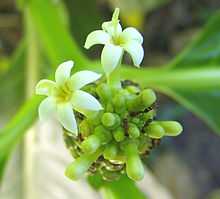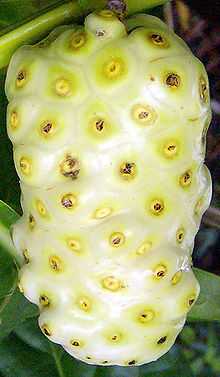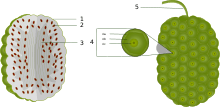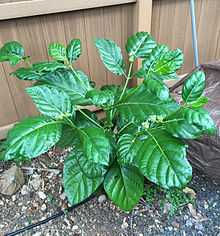Morinda citrifolia
| Morinda citrifolia | |
|---|---|
.jpg) | |
| Leaves and fruit | |
| Scientific classification | |
| Kingdom: | Plantae |
| (unranked): | Angiosperms |
| (unranked): | Eudicots |
| (unranked): | Asterids |
| Order: | Gentianales |
| Family: | Rubiaceae |
| Genus: | Morinda |
| Species: | M. citrifolia |
| Binomial name | |
| Morinda citrifolia L. | |
Morinda citrifolia is a tree in the coffee family, Rubiaceae. Its native range extends through Southeast Asia,Central America, and Australasia, and the species is now cultivated throughout the tropics and widely naturalised.[1]
English common names include great morinda,[2] Indian mulberry, noni,[2] beach mulberry, and cheese fruit.[2]
Growing habitats

M. citrifolia grows in shady forests, as well as on open rocky or sandy shores. It reaches maturity in about 18 months, then yields between 4 and 8 kg (8.8 and 17.6 lb) of fruit every month throughout the year. It is tolerant of saline soils, drought conditions, and secondary soils. It is therefore found in a wide variety of habitats: volcanic terrains, lava-strewn coasts, and clearings or limestone outcrops, as well as in coralline atolls.[3] It can grow up to 9 m (30 ft) tall, and has large, simple, dark green, shiny and deeply veined leaves.
The plant bears flowers and fruits all year round. The fruit is a multiple fruit that has a pungent odour when ripening, and is hence also known as cheese fruit or even vomit fruit. It is oval in shape and reaches 10–18 centimetres (3.9–7.1 in) size. At first green, the fruit turns yellow then almost white as it ripens. It contains many seeds. It is sometimes called starvation fruit. Despite its strong smell and bitter taste, the fruit is nevertheless eaten as a famine food[4] and, in some Pacific islands, even a staple food, either raw or cooked.[5] Southeast Asians and Australian Aborigines consume the fruit raw with salt[6] or cook it with curry. The seeds are edible when roasted.
M. citrifolia is especially attractive to weaver ants, which make nests from the leaves of the tree. These ants protect the plant from some plant-parasitic insects. The smell of the fruit also attracts fruit bats, which aid in dispersing the seeds. A type of fruit fly, Drosophila sechellia, feeds exclusively on these fruits.[7]
Nutrients and phytochemicals

M. citrifolia fruit powder contains carbohydrates and dietary fibre in moderate amounts.[8] These macronutrients evidently reside in the fruit pulp, as M. citrifolia juice has sparse nutrient content.[9] The main micronutrients of M. citrifolia pulp powder include vitamin C, niacin (vitamin B3), iron and potassium.[8] Vitamin A, calcium and sodium are present in moderate amounts. When M. citrifolia juice alone is analyzed and compared to pulp powder, only vitamin C is retained[9] in an amount that is about half the content of a raw navel orange.[10] Sodium levels in M. citrifolia juice (about 3% of Dietary Reference Intake, DRI)[8] are high compared to an orange, and potassium content is moderate. The juice is otherwise similar in micronutrient content to a raw orange.[10]
M. citrifolia fruit contains a number of phytochemicals, including lignans, oligo- and polysaccharides, flavonoids, iridoids, fatty acids, scopoletin, catechin, beta-sitosterol, damnacanthal, and alkaloids. Although these substances have been studied for bioactivity, current research is insufficient to conclude anything about their effects on human health.[11][12][13][14][15] These phytochemicals are not unique to M. citrifolia, as they exist in various plants.
Gastronomic uses


In Thai cuisine, the leaves (known as bai-yo, ใบยอ) are used as a green vegetable and the fruit (luk-yo, ลูกยอ) is added as a salad ingredient to some versions of somtam.
Traditional medicine
There are modern, unconfirmed, claims that green fruit, leaves, and root/rhizomes might have been used in Polynesian cultures to as a general tonic, in addition to its traditional place in Polynesian culture as a famine food.[16]
In Traditional Chinese Medicine, the roots, known as Ba Ji Tian, have been used to treat abdominal pain, impotence, and menstrual disorders.[17][18]
Consumer uses
Morinda bark produces a brownish-purplish dye that may be used for making batik. In Hawaii, yellowish dye is extracted from its roots to dye cloth.[19]
There have been recent applications for the use of M. citrifolia seed oil[20] which contains linoleic acid, possibly useful when applied topically to skin, e.g., for anti-inflammation, acne reduction, or moisture retention.[21][22][23]
See also
References
- ↑ Nelson, SC (2006-04-01). "Species Profiles for Pacific Island Agroforestry: Morinda citrifolia (noni)". Traditional Tree Initiative.
- ↑ 2.0 2.1 2.2 Plants by Common Name – James Cook University
- ↑ Xavier Romero-Frias, The Maldive Islanders, A Study of the Popular Culture of an Ancient Ocean Kingdom, Barcelona 1999, ISBN 84-7254-801-5
- ↑ Krauss, BH (1993). Plants in Hawaiian Culture. Honolulu: University of Hawaii Press.
- ↑ Morton, Julia F. (1992). "The ocean-going noni, or Indian Mulberry (Morinda citrifolia, Rubiaceae) and some of its "colorful" relatives". Economic Botany 46 (3): 241–56. doi:10.1007/BF02866623.
- ↑ Cribb, A.B. & Cribb, J.W. (1975) Wild Food in Australia. Sydney: Collins.
- ↑ Jones, C.D. (1998). "The Genetic Basis of Drosophila sechellia's Resistance to a Host Plant Toxin". Genetics 149 (4): 1899–1908.
- ↑ 8.0 8.1 8.2 Nelson, Scot C. (2006) "Nutritional Analysis of Hawaiian Noni (Noni Fruit Powder)" The Noni Website. Retrieved 15-06-2009.
- ↑ 9.0 9.1 Nelson, Scot C. (2006) "Nutritional Analysis of Hawaiian Noni (Pure Noni Fruit Juice)" The Noni Website. Retrieved 15-06-2009.
- ↑ 10.0 10.1 World's Healthiest Foods, in-depth nutrient analysis of a raw orange
- ↑ Saleem, Muhammad; Kim, Hyoung Ja; Ali, Muhammad Shaiq; Lee, Yong Sup (2005). "An update on bioactive plant lignans". Natural Product Reports 22 (6): 696–716. doi:10.1039/b514045p. PMID 16311631.
- ↑ Deng, Shixin; Palu, ‘Afa K.; West, Brett J.; Su, Chen X.; Zhou, Bing-Nan; Jensen, Jarakae C. (2007). "Lipoxygenase Inhibitory Constituents of the Fruits of Noni (Morindacitrifolia) Collected in Tahiti". Journal of Natural Products 70 (5): 859–62. doi:10.1021/np0605539. PMID 17378609.
- ↑ Lin, Chwan Fwu; Ni, Ching Li; Huang, Yu Ling; Sheu, Shuenn Jyi; Chen, Chien Chih (2007). "Lignans and anthraquinones from the fruits ofMorinda citrifolia". Natural Product Research 21 (13): 1199–204. doi:10.1080/14786410601132451. PMID 17987501.
- ↑ Levand, Oscar; Larson, Harold (2009). "Some Chemical Constituents of Morinda citrifolia". Planta Medica 36 (06): 186–7. doi:10.1055/s-0028-1097264.
- ↑ Mohd Zin, Z.; Abdul Hamid, A.; Osman, A.; Saari, N.; Misran, A. (2007). "Isolation and Identification of Antioxidative Compound from Fruit of Mengkudu (Morinda citrifoliaL.)". International Journal of Food Properties 10 (2): 363–73. doi:10.1080/10942910601052723.
- ↑ Wang MY, West BJ, Jensen CJ, Nowicki D, Su C, Palu AK, Anderson G (2002). "Morinda citrifolia (Noni): a literature review and recent advances in Noni research". Pharmacol Sin 23 (12): 1127–41. PMID 12466051.
- ↑ "Ba Ji Tian". WebMD. Retrieved 2014-10-13.
- ↑ "Morinda Root". Hong Kong Baptist University.
- ↑ Thompson, RH (1971). Naturally Occurring Anthraquinones. New York: Academic Press.
- ↑ West, Brett J.; Jarakae Jensen, Claude; Westendorf, Johannes (2008). "A new vegetable oil from noni (Morinda citrifolia) seeds". International Journal of Food Science & Technology 43 (11): 1988–92. doi:10.1111/j.1365-2621.2008.01802.x.
- ↑ Diezel, W.E.; Schulz, E.; Skanks, M.; Heise, H. (1993). "Plant oils: Topical application and anti-inflammatory effects (croton oil test)". Dermatologische Monatsschrift 179: 173.
- ↑ Letawe, C; Boone, M; Pierard, GE (1998). "Digital image analysis of the effect of topically applied linoleic acid on acne microcomedones". Clinical and Experimental Dermatology 23 (2): 56–8. doi:10.1046/j.1365-2230.1998.00315.x. PMID 9692305.
- ↑ Darmstadt, GL; Mao-Qiang, M; Chi, E; Saha, SK; Ziboh, VA; Black, RE; Santosham, M; Elias, PM (2007). "Impact of topical oils on the skin barrier: possible implications for neonatal health in developing countries". Acta Paediatrica 91 (5): 546–54. doi:10.1080/080352502753711678. PMID 12113324.
Further reading
| Wikisource has the text of the 1911 Encyclopædia Britannica article Aal. |
- Elevitch, Craig R.; Nelson, Scot C. (August 2006). Noni: The Complete Guide for Consumers and Growers. Permanent Agriculture Resources. p. 112. ISBN 0-9702544-6-6.
External links
| Wikimedia Commons has media related to: |
- Crop of the Week: Noni (Morinda citrifolia, Rubiaceae)
- "The Noni Website". University of Hawaii. 2006.
- Thomas, Chris (August 30, 2002). "Noni No Miracle Cure". Cancerpage.com.
- Anthony, Mark. "Noni or NIMBY?". Foodprocessing.com.